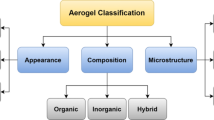Abstract
The effect of the composition and bonding configuration of the bioactive silica-based glasses on the initial stage in vitro bioactivity is presented. Information of the IR active Si–O groups of glass in the system SiO2–P2O5–CaO–Na2O–K2O–MgO–B2O3 was obtained by fourier transform Infrared (FTIR) spectroscopy. Two different bands associated to non-bridging oxygen stretching vibrations (Si–O–1NBO and Si–O–2NBO) and a gradual shifting of the bridging oxygen stretching vibration (Si–O) have been observed and evaluated. Both effects are attributed to a decrease of the local symmetry originating from the incorporation of alkali ions into the vitreous silica network. The Si–O–NBO(s)/Si–O(s) absorbance intensity ratio increases with a gradual incorporation of the alkali ions (diminution of SiO2 content) following a linear dependence up to values close to 50 wt % of SiO2. In vitro test analysis by scanning electron microscopy (SEM) and energy dispersive X-ray analysis (EDXA) showed a correlation between the amount and type of the non-bridging oxygen functional groups and the growth of the silica-rich and CaP layers. It was found that a minimum concentration of Si–O–NBO bonds in the glass network is required in order to have an efficient ion exchange and dissolution of the silica network. Finally, the bioactivity of the glass is favored by the presence of the Si–O–2NBO groups in the glassy network. The role of these functional groups in the dissolution of the silica network through the formation of silanol groups and the adsorption of water is discussed.
Similar content being viewed by others
References
L. L. Hench and J. Wilson (eds.) “An Introduction to Bioceramics” (World Scientific, Singapore, 1993).
T. Yamamuro, L. L. Hench and J. Wilson (eds.) “Handbook of Bioactive Ceramics” (CRC Press, Boca Raton FL, 1990).
P. GonzÁlez, J. Serra, S. Liste, S. Chiussi, B. LeÓn and M. PÉrez-Amor, Vacuum 67 (2002) 647.
H. Scholze “Glass: Nature, Structure and Properties” (Springer-Verlag, New York, 1990).
K. H. Karlsson and H. O. YlÄnen, in “Proceedings Book of Advances in Science and Technology 28 and 9th Cimtec-World Forum on New Materials, Florencia, June 1998”, edited by P. Vincenzini (Techna, Italy, 1999).
Z. Strand, Biomaterials 13 (1978) 862.
R. W. Cahn, P. Haasen and E. J. Kramer (eds.) “Materials Science and Technology; Glasses and Amorphous Materials” (VCH Publishers, New York, 1991).
W. A. Pliskin, J. Vac. Sci. Technol. 14 (1977) 1064.
P. Lange, J. Appl. Phys. 66 (1989) 201.
P. Lange, U. Schnakenberg, S. Ullerich and J. Schliwinski, ibid. 68 (1990) 3532.
F. L. Galeener and G. Lucovsky, Physical Review Letters 37 (1976) 1474.
D. M. Sanders, W. B. Person and L. L. Hench, Applied Spectroscopy 28 (1974) 247.
T. Kokubo, M. Tanahashi, T. Yao, M. Minoda, T. Miyamoto, T. Nakamura and T. Yamamuro, Bioceramics 6 (1993) 327.
P. G. Pai, S. S. Chao, Y. Takagi and G. Lucovsky, J. Vac. Sci. Technol. A 4 (1986) 689.
E. G. Parada, P. GonzÁlez, J. Pou, J. Serra, D. FernÁndez, B. LeÓn and M. PÉrez-Amor, ibid. 14 (1996) 436.
K. Awazu, J. Non-Cryst. Solids 260 (1999) 242.
A. C. Adams, Solid State Technol. 26 (1983) 135.
C. R. Helms and E. A. Poindexter, Rep. Prog. Phys. 57 (1994) 791.
Author information
Authors and Affiliations
Rights and permissions
About this article
Cite this article
Serra, J., González, P., Liste, S. et al. Influence of the non-bridging oxygen groups on the bioactivity of silicate glasses. Journal of Materials Science: Materials in Medicine 13, 1221–1225 (2002). https://doi.org/10.1023/A:1021174912802
Issue Date:
DOI: https://doi.org/10.1023/A:1021174912802




